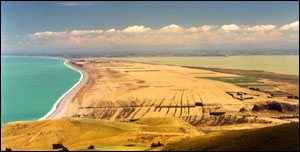 This long sandy spit that separates Te Waihora (Lake Ellesmere) from the sea was once an important thoroughfare for Māori travelling from Horomaka (Banks Peninsula) to settlements such as Kaiapoi and Kaikōura.
This long sandy spit that separates Te Waihora (Lake Ellesmere) from the sea was once an important thoroughfare for Māori travelling from Horomaka (Banks Peninsula) to settlements such as Kaiapoi and Kaikōura.
Kaitōrete provided ease of travel when compared to the swampy route inland around the edges of Te Waihora.
The remains of many ovens and middens along Kaitōrete’s length are an indication of the great numbers of people who travelled this ancient highway which extends for nearly 30 kilometres down Te Wai Pounamu’s eastern coast.
 Kaitōrete is flanked by Taumutu at its southern end and the site of Waikākahi pā in the north.
Kaitōrete is flanked by Taumutu at its southern end and the site of Waikākahi pā in the north.
It remains an important mahinga kai for foods such as birds’ eggs and tuna and is an important source of weaving materials such as pīngao.
The area is steeped in the histories of Ngāi Tahu, Ngāti Māmoe and Waitaha.
Sources
- Anon, dedicated to Riki Ellison. ‘The Food Basket of Rakaihautu’: Taumutu, The Past Today: Historic Places in New Zealand, Ed. John Wilson, Pacific Publishers, 1987
- Waihora: Lake Ellesmere Past, Present and Future. Eds. J. Davies, L. Galloway, A. Nutt, Lincoln University Press and Daphne Brasell Associates Ltd, 1994
- Te Maire Tau, Anake Goodall, David Palmer & Rakiihia Tau. Te Whakatau Kaupapa: Ngāi Tahu Resource Management Strategy for the Canterbury Region, Aoraki Press, 1990
